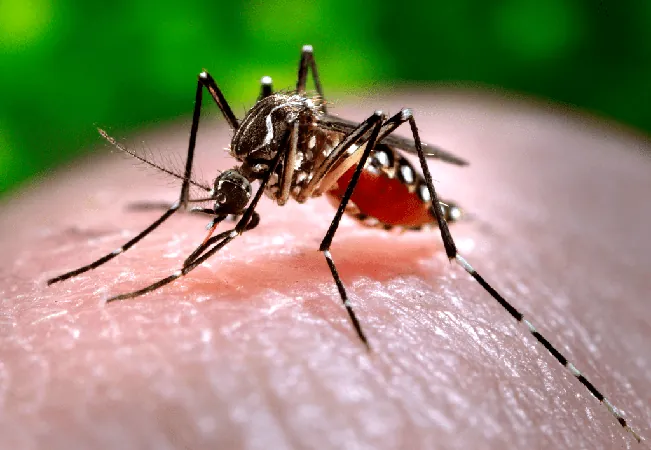
The Dengge Virus: Is It Manipulating Aedes aegypti Mosquitoes or Just an Unfortunate Side Effect?
2025-01-24
Author: Yu
The Dengue Virus: An Overview
The dengue fever virus, primarily spread by the yellow fever mosquito (Aedes aegypti), continues to pose significant health risks globally. According to the World Health Organization (WHO), an alarming 4.6 million cases were reported in 2023 alone. Dengue fever can range from mild flu-like symptoms to severe manifestations such as hemorrhagic fever and even death. The virus comprises four serotypes—DENV-1, DENV-2, DENV-3, and DENV-4—each capable of causing disease, and its impact is intensifying particularly in tropical and subtropical regions. As climate change expands their habitat, Aedes aegypti is spreading further, leading to rising cases of dengue.
Research Insights
A recent review by researchers Ioana Mateescu and Sebastian Lequime from the University of Groningen delved into how the dengue virus interacts with its mosquito host, Aedes aegypti, particularly focusing on vectorial capacity—the ability of the mosquito to transmit the disease. Their study highlighted the intriguing question of whether the dengue virus is manipulating its host or if the observed changes in mosquito behavior and survival are merely byproducts of infection.
Mosquito Behavior and Vectorial Capacity
Elements that contribute to the mosquitoes' ability to transmit the virus include their behavior concerning locomotion, host-seeking, and feeding patterns. Previous studies have shown conflicting results regarding the effects of dengue infection on these behaviors. For instance, some research indicates that locomotor activity in infected mosquitoes increases in the days following infection, whereas other studies have observed a drop in activity after a certain period. Feeding patterns also show variability; while some reports suggest increased feeding times, others find no significant change in behavior post-infection.
Life History Traits
In terms of life history traits related to vectorial capacity—like survival and fecundity—the findings are equally perplexing. While infections with DENV-1 and DENV-2 have been shown to reduce mosquito survival, studies on DENV-4 report no significant impact. The effect of dengue infection on the reproductive capabilities of these mosquitoes remains largely unexplored and is a matter of ongoing inquiry.
Ongoing Research Challenges
The debate over whether the virus exerts control over its host or simply coexists as a byproduct of infection presents a complex challenge for researchers. Establishing whether infection confers advantages to the virus in terms of transmission would require extensive comparative studies across different serotypes and methodologies. Mateescu and Lequime’s review uncovered a serious gap in current understanding, largely due to the diverse nature of previous research.
The Importance of Standardized Methodology
Additionally, for scientists to derive meaningful conclusions, a standardized methodology for studying these interactions is essential, something that has been noted as a major hurdle in the field. With the considerable diversity in experimental approaches, comparison between studies is often fraught with complications.
Implications for Future Research
As dengue cases soar globally, the implications of understanding the relationship between the virus and its mosquito vectors are critical. The study underscores an urgent need for further research not only on Aedes aegypti but also on other vectors that might carry different arboviruses. Such findings could play a pivotal role in developing strategies to reduce the burden of dengue fever and potentially other vector-borne diseases.
Conclusion
Research on the intricate dynamics of dengue virus and Aedes aegypti holds tremendous promise. As highlighted by Lequime, the significance of these interactions must be integrated into epidemic risk models moving forward. By piecing together the puzzle of how the virus affects its host, scientists and public health officials can better prepare for and possibly mitigate the impacts of dengue fever in the future. In summary, as scientific inquiry continues, the answer to whether the dengue virus is cleverly manipulating its vector or merely accompanying it as a byproduct remains tantalizingly elusive. However, advancements in this research field may soon provide the clarity needed to combat the growing threat of dengue fever globally.


 Brasil (PT)
Brasil (PT)
 Canada (EN)
Canada (EN)
 Chile (ES)
Chile (ES)
 Česko (CS)
Česko (CS)
 대한민국 (KO)
대한민국 (KO)
 España (ES)
España (ES)
 France (FR)
France (FR)
 Hong Kong (EN)
Hong Kong (EN)
 Italia (IT)
Italia (IT)
 日本 (JA)
日本 (JA)
 Magyarország (HU)
Magyarország (HU)
 Norge (NO)
Norge (NO)
 Polska (PL)
Polska (PL)
 Schweiz (DE)
Schweiz (DE)
 Singapore (EN)
Singapore (EN)
 Sverige (SV)
Sverige (SV)
 Suomi (FI)
Suomi (FI)
 Türkiye (TR)
Türkiye (TR)
 الإمارات العربية المتحدة (AR)
الإمارات العربية المتحدة (AR)